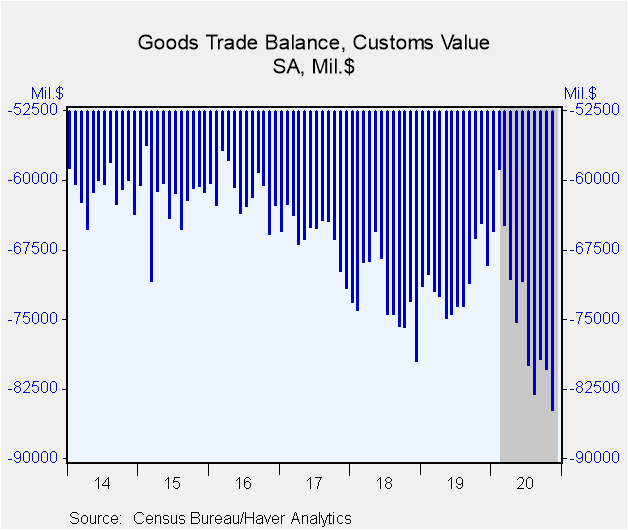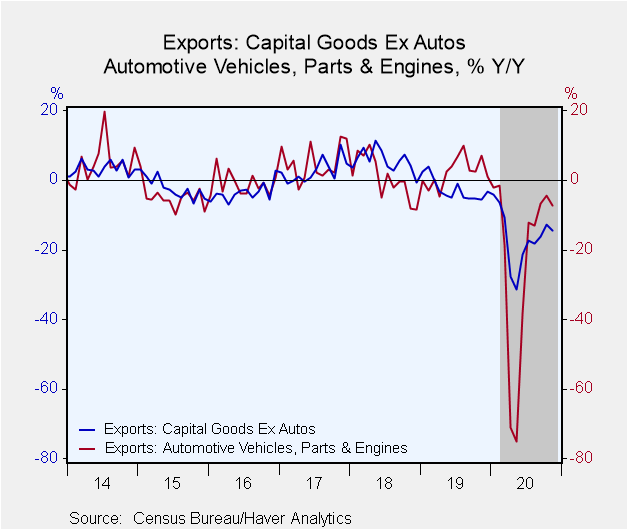 Global| Dec 30 2020
Global| Dec 30 2020Trade Deficit Widens in November
by:Sandy Batten
|in:Economy in Brief
Summary
• Widening much larger than expected. • Net exports to be drag on overall GDP growth in Q4. • Export growth slows while import gain accelerates. The advance estimate of the U.S. trade deficit in goods widened to $84.8 billion in [...]
• Widening much larger than expected.
• Net exports to be drag on overall GDP growth in Q4.
• Export growth slows while import gain accelerates.
The advance estimate of the U.S. trade deficit in goods widened to $84.8 billion in November from $80.4 billion in October, revised from $80.3 billion. The Action Economics Forecast Survey expected an $81.5 billion deficit. Exports edged up 0.8% m/m (-7.5% y/y) after a 3.0% rise in October while imports rose 2.6% m/m (6.2% y/y) on top of a 2.3% m/m gain in October. The continued widening of the deficit in November points to net exports being a further drag on overall GDP growth in Q4.
The sluggishness in exports reflected a 1.1% m/m (-7.3% y/y) decline in exports of automotive vehicles and parts and a 0.7% m/m (-14.4% y/y) drop capital goods exports excluding autos. By contrast, exports of foods and feeds jumped up 4.3% m/m (19.9% y/y) in November. The continued strong gain in imports in November was led by a 6.7% m/m (17.6% y/y) surge in imports of nonfood consumer goods, a 2.9% m/m (-4.5% y/y) rise in industrial supplies, and a 2.0% m/m (4.7% y/y) gain in capital goods exports.
The advance international trade data can be found in Haver's USECON database. The expectation figure is from the Action Economics Forecast Survey, which is in AS1REPNA.
| Advance U.S. Foreign Trade in Goods (Customs Value $) | Nov | Oct | Sep | Nov Y/Y | 2019 | 2018 | 2017 |
|---|---|---|---|---|---|---|---|
| U.S. Trade Deficit ($ bil.) | -84.82 | -80.42 | -79.36 | -64.72 (11/19) |
-854.37 | -872.04 | -792.40 |
| Exports (% Chg) | 0.8 | 3.0 | 3.2 | -7.5 | -1.4 | 7.7 | 6.6 |
| Imports (% Chg) | 2.6 | 2.3 | 0.0 | 6.2 | -1.6 | 8.5 | 7.0 |
Note: Current month is based on Advance Trade data; Previous months reflect revised data from International Trade release.
Sandy Batten
AuthorMore in Author Profile »Sandy Batten has more than 30 years of experience analyzing industrial economies and financial markets and a wide range of experience across the financial services sector, government, and academia. Before joining Haver Analytics, Sandy was a Vice President and Senior Economist at Citibank; Senior Credit Market Analyst at CDC Investment Management, Managing Director at Bear Stearns, and Executive Director at JPMorgan. In 2008, Sandy was named the most accurate US forecaster by the National Association for Business Economics. He is a member of the New York Forecasters Club, NABE, and the American Economic Association. Prior to his time in the financial services sector, Sandy was a Research Officer at the Federal Reserve Bank of St. Louis, Senior Staff Economist on the President’s Council of Economic Advisors, Deputy Assistant Secretary for Economic Policy at the US Treasury, and Economist at the International Monetary Fund. Sandy has taught economics at St. Louis University, Denison University, and Muskingun College. He has published numerous peer-reviewed articles in a wide range of academic publications. He has a B.A. in economics from the University of Richmond and a M.A. and Ph.D. in economics from The Ohio State University.










